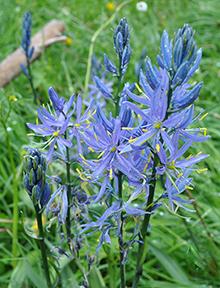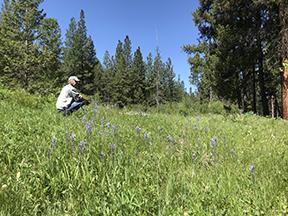You are viewing ARCHIVED content published online before January 20, 2025. Please note that this content is NOT UPDATED, and links may not work. Additionally, any previously issued diversity, equity, inclusion or gender-related guidance on this webpage should be considered rescinded. For current information, visit https://www.blm.gov/blog.
Missoula Field Office BLM and the Confederated Salish and Kootenai Tribes use Reserved Treaty Rights Lands Program funds to enhance camas in the Blackfoot Valley
Story by Jennifer McNew, Range Technician and Michael Albritton, Fuels Specialist
Before European colonization, for a few short weeks every year, meadows in Western Montana became vast seas of camassia quamash, also known as common camas.

Camas is in the lily family; it has large blue flowers and each plant grows from a nutrient dense bulb. Its root was and continues to be an extremely important food crop to many Native Americans in what is now the Western United States. Not only does it provide calories and nutrients, but the camas bulb was also one of the main sources of sweetening before the introduction of sugar.
Homesteading in the West caused most camas habitat to be sectioned off and converted to agriculture or pasture, bringing in non-native grasses and forbs that outcompeted and sometimes nearly erased native plant communities. Some of these areas are still privately owned and some are now public lands managed by the BLM and other land management agencies.
Native Americans tended Camas meadows with intention, using special harvesting practices and fire to promote healthy populations that would be sustained through generations for future harvest. Due to past land ownership practices and a lack of traditional intentional tending, Camas fields in Western Montana have largely declined. BLM land along the lower Blackfoot River contains some of these remnant populations. The Missoula Field Office is currently working with the Confederated Salish and Kootenai Tribes (CSKT) and The Nature Conservancy (TNC) to restore Camas habitat and populations in the Lower Blackfoot River Corridor.

In 2018, the Missoula Field Office worked with the CSKT’s Forestry and Fuels programs and TNC to develop the Lower Blackfoot River Forest & Meadow Restoration Reserved Treaty Rights Lands (RTRL) project. The RTRL program was started in 2015 by the Bureau of Indian Affairs’ Fuels Management Program with the intention to treat and restore tribal landscapes within and adjacent to reserved treaty right lands, especially ancestral areas that are at a high risk of degradation due to wildland fire. In addition to improving resiliency of forests to disturbances like fire, insects and disease, this project also focuses on camas meadow habitat restoration. Project objectives include improvement of native plant communities for wild ungulates as well as for the two plants identified as culturally significant to CSKT: bitterroot and camas.
Guided by CSKT, The Missoula Field Office and TNC are implementing projects across disciplines to improve camas and bitterroot habitat. Forestry, weeds, archeology, and botany technicians have surveyed for populations of these important plants. To date, the office has documented more than 20 acres of camas as well as 38 acres of bitterroot.
Weeds technicians spray herbicide after camas has senesced (deteriorated with age) each year to decrease competition with non-native forbs and grasses *. Foresters and Fuels specialists have carried out 50 acres of thinning and fire treatments to eliminate conifer encroachment and to free up much needed moisture and nutrients for nearby camas populations. Botany Technicians have collected pounds of seed to save for future projects and to reseed after thinning and burning treatments. Populations are monitored before and after treatments to quantify how camas populations change and preliminary results are showing an increase in camas quantity.
In the next few years, the Missoula Field Office is planning camas habitat restoration in an abandoned homestead which was likely once a camas meadow. They will burn the twelve-acre site and immediately following, spread locally collected seed from camas and its associated species.
In addition to seeding camas, the BLM is working with the CSKT nursery to grow out camas bulbs for planting after burning. A combination of seeds and plugs will be dispersed on site to increase the chance for camas to take root and thrive in the area.
This camas habitat restoration work along with associated RTRL projects that have been implemented in partnership with the CSKT since 2018 have helped to begin building meaningful relationships with the Tribes that will be used in the future to recognize and honor the importance of tribal uses on lands currently being managed by BLM.
* Camas effectively goes dormant after it sets seed mid-summer. Limited research shows that camas can be safe to consume after these treatments.
Rice, Peter 2002, ‘Herbicide Residue Analysis of Cultural Plants on the Flathead Indian Reservation’, EPA Grant MM998750-01-0.
Related Stories
- Monument map earns ‘finalist’ honors in global GIS awards
- Tucson Field Office and local tribe coordinate on land management strategies
- Recreation for all: Accessibility on Montana-Dakotas public lands
- North Central Montana District employees celebrate new adoption
- BLM Billings Field Office works with state agencies in Montana to conduct bat surveys
